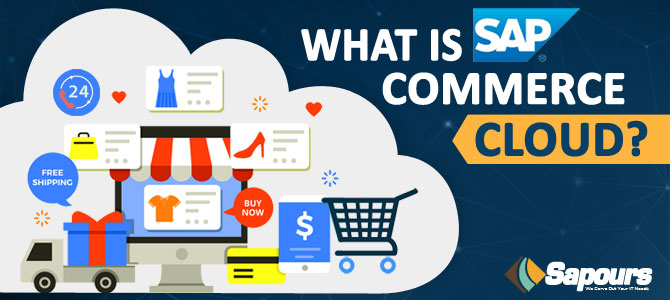Ever wondered what point we really started shopping online at? It was not in the most interesting way, actually – Boston Computer Exchange is credited as the first to launch an e-commerce platform in 1982 – and they were selling used computers online.
Of course, e-commerce did not remain in the purview of techies alone, and by 1995 Amazon and eBay started the online shopping revolution for the masses.
By 2000, the dotcom bust had driven many of the early e-commerce players out of the market. From then on, after many consolidations, e-commerce finally started taking root in countries all over the globe.
Fast forward to 2020 – Covid-19 has caused online shopping to be the primary method of shopping – driving even the most reluctant businesses into digital commerce.
SAP Commerce – Leading the way:
One of the leading digital commerce platforms today is from the international giant, SAP. The SAP Commerce Cloud as it’s called now has quite a history.
It had its origins in a product called hybris, the lowercase ‘h’ is the way the brand preferred to spell it. A powerful product, SAP soon saw its potential and bought the brand in 2013, renaming it to SAP Hybris. Now backed by SAP, the product – or product suite rather, grew by leaps and bounds and became recognized by Gartner as a leader in the Magic Quadrant for Digital Commerce. Very recently, in 2018, the product was once more renamed to SAP CX Commerce. Now, with SAP’s move towards Cloud, the product is referred to as SAP Commerce Cloud. But what’s in a name?!
Commerce on Cloud:
As described by SAP the company itself, SAP Commerce Cloud is all about personalizing the commerce experience down to the micro-moment, with what SAP calls ‘context-driven services’. The emphasis is on delivering the shopping experience customers expect today using personalization and SAP CX’s focus on Cloud. SAP Commerce clients will eventually be encouraged to migrate to the public cloud using SAP C/4 Hana on MS Azure Cloud. SAP C/4 Hana combines the commerce and marketing features of SAP Hybris with front-office CRM and ERP at the backend.
Moving to the cloud brings many benefits to e-tailers. Not only does it simplify the platform features, but it also brings in business agility and supports innovation due to its quick and simple development, maintenance, and support.
Omnichannel features are the hallmark of SAP Commerce Cloud and this means retailers can satisfy the growing demands of customers who are shopping from multiple devices and even multiple physical touchpoints.
Comprehensive solution:
SAP Commerce Cloud is a comprehensive platform, providing businesses with the ability to launch multiple localized stores on a single platform – whether for B2B, B2C, B2B2C, and other models of e-commerce. While on the one hand, the product focuses on the shopping experience of the customer, at the platform level, it comes packed with many capabilities:
- SAP Commerce comes with a set of pre-built industry-specific accelerators with ready storefront templates, making it quick and easy for e-tailers to launch a storefront that is customized to their industry segment and addresses their specific challenges.
- An easy-to-use repository makes Product Content Management or PCM, one of SAP Commerce’s star capabilities. Whether it is the ability to create bundles of products or services to bring out unique offers, or define flexible pricing rules or even present personalized offers, SAP Commerce create opportunities for e-tailers to increase the average basket value and provide a better shopping experience.
- SAP Commerce allows multiple localized storefronts on a single platform – which means brands can easily go global– launching separate portals for separate geographies and personalizing each to the local currency, language, regulations, and logistics.
- Context-driven services allow for a high degree of personalization. The SmartEdit WYSIWYG editing tool gives e-tailers a drag-and-drop interface to quickly and easily create new offer pages and promotional banners on-the-fly. This allows them to display highly personalized storefront displays to returning customers and use the power of remarketing to drive up conversion rates.
- One of the main challenges for e-tailers who operate in multiple geographies is order fulfillment and managing returns, customer complaints. Manual or paper-based order management is prone to errors – automation of these processes yields higher customer satisfaction scores as well as efficiency improvements.
- Since SAP Commerce Cloud is part of the CX suite, it comes with pre-built, tight integrations to other SAP Cloud products such as SAP Marketing Cloud, SAP Sales Cloud, SAP Customer Data Cloud, and SAP Service Cloud.
New kid on the commerce block: SAP Spartacus
SAP Commerce Cloud now includes the open-source PWA, Spartacus. This is a headless commerce application – which means it completely decouples the online store’s frontend experience from the backend platform. This keeps the frontend very flexible, easy to update and redesign without affecting any backend configurations. Written in Angular, it uses libraries extensively and leverages the OCC API. Spartacus delivers a native-app experience while retaining the ability to work offline – which is lacking in native apps. Take a look at RetailCX – the Spartacus-based framework built by Sapours specifically for the F&B industry.
Need to take your business online quickly?
Want to discover how Sapours can deliver a unified, omnichannel shopping experience to your customers?
Sapours Quick Deployment Framework (QDF) delivers faster time-to-value for e-commerce implementations. Ask for a demo today.
Author details –

Deepali Thakur.
SAP Hybris Commerce Lead
9+ Years of professional experience in Design, Development, and Deployment of the e-commerce solutions and Enterprise search solutions

